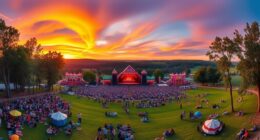At Coachella, you’re stepping onto stages that have defined the festival experience since 1999. The Legendary Coachella Stage showcases iconic acts, while the Sahara Tent revolutionizes electronic music. Intimate vibes in the Mojave and Gobi Tents create a unique atmosphere, and the Yuma Tent highlights underground sounds. Each stage tells a story and enhances the festival’s cultural impact. There’s so much more to uncover about these legendary spots and their unforgettable moments.
Key Takeaways
- The Legendary Coachella Stage evolved to accommodate larger crowds and complex performances, hosting iconic acts like Beck and Tool since 1999.
- The Sahara Tent, crucial for electronic music, transformed into a steel structure, enhancing productions with advanced lighting and audio systems.
- Mojave and Gobi Tents provide intimate settings for indie rock and surprise acts, creating deep connections between artists and festival-goers.
- The Yuma Tent has become a cultural landmark for electronic music, featuring renowned artists and an immersive atmosphere for fans.
- Iconic performances, such as Daft Punk’s 2006 pyramid stage and Beyoncé’s “Beychella,” have shaped Coachella’s reputation and influence on music culture.
The Legendary Coachella Stage
The Legendary Coachella Stage stands as the heart of the festival, drawing in music lovers from around the globe since 1999. Located at the Empire Polo Club in Indio, California, this main outdoor stage has hosted headlining acts across various genres, from rock to pop and electronic music. You can’t forget iconic performances by artists like Beck, Tool, and Rage Against the Machine during its inaugural year. Over time, the stage’s design evolved, accommodating larger crowds and more complex performances. Moments like Pavement’s infamous near-breakup onstage in 1999 and reunions of bands such as Siouxsie and the Banshees highlight its historical significance. The Coachella Stage truly embodies the festival’s spirit and musical diversity, making it a must-see for attendees. Diverse genres showcased on this stage have contributed to Coachella’s reputation as a cultural phenomenon.
The Evolution of the Sahara Tent
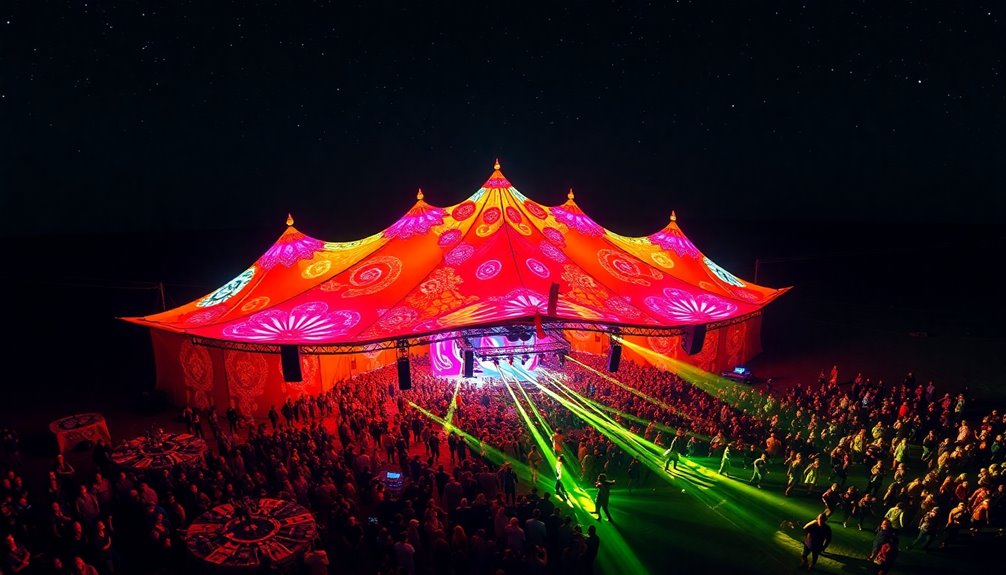
While the Coachella Stage captures the festival’s essence, the Sahara Tent has carved out its own legendary status within the festival grounds.
Since its inception, it’s been a cornerstone for electronic and dance music, launching iconic acts like Daft Punk in 2006.
Originally located far from the main attractions, the Sahara Tent has evolved, relocating and rebuilding to meet growing demand. Its recent transformation into a steel structure allows for more elaborate productions, enhancing your experience with advanced lighting and audio systems. This new infrastructure unlocks exciting possibilities for production and stage design, ensuring each performance is unforgettable.
Hosting a diverse mix of genres, including rap and pop, it remains the “beating heart” of Coachella, continually influencing the broader music festival landscape and shaping the future of electronic music in the U.S.
Intimate Vibes: Mojave and Gobi Tents
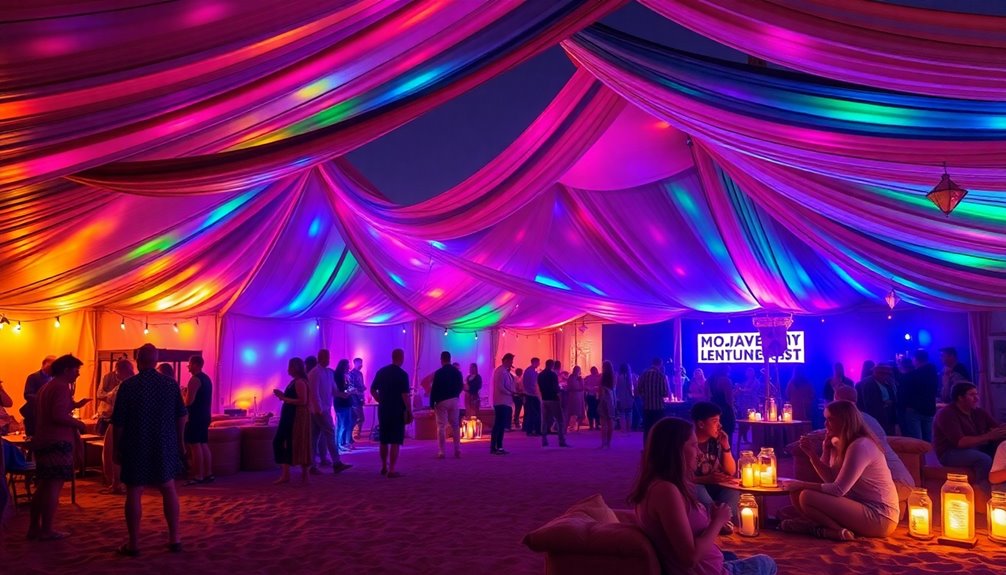
Nestled among the vibrant festival grounds, the Mojave and Gobi Tents offer an intimate escape from the bustling energy of Coachella.
The Mojave Tent, located near the rose garden, showcases indie rock and emerging artists in a vibrant, colorful setup, focusing on captivating performances rather than flashy visuals. It’s the perfect refuge from the desert heat, providing a shaded area for fans. Coachella is known for its glamorous Instagram moments, making the Mojave a popular spot for festival-goers seeking memorable photos.
Just a stone’s throw away, the Gobi Tent serves as a launchpad for artists, packing energetic performances into its smaller space. Known for surprise acts, it draws diverse genres, stealing attention from the outdoor stages.
Both tents create a unique atmosphere where artists and audiences connect deeply, making unforgettable memories in an intimate setting.
The Underground Scene at Yuma Tent
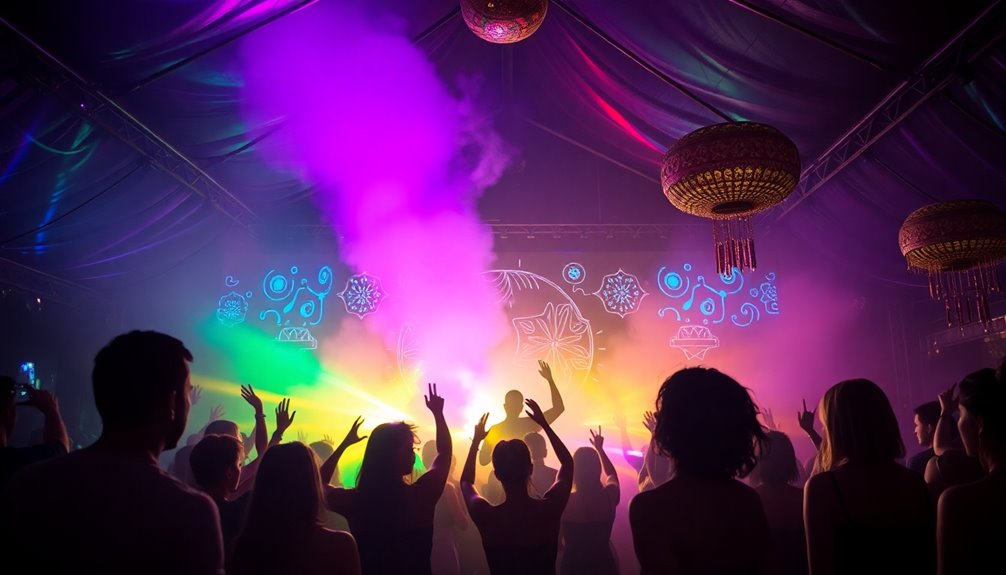
After soaking in the intimate vibes of the Mojave and Gobi Tents, you might find yourself drawn to the pulsating energy of the Yuma Tent.
This once-secluded underground haven has transformed into a main attraction, celebrated for its electrifying electronic music programming, especially techno and deep house. Key venue for dance music programming, the Yuma Tent continues to attract a dedicated audience of electronic music fans.
As you step inside, you’ll discover a unique blend of melodic techno and deep house acts, featuring renowned artists like Adriatique and Gorgon City alongside rising stars like Kevin de Vries.
The immersive atmosphere, enhanced by stunning lighting, invites you to lose yourself on the vibrant dance floor.
The Yuma Tent isn’t just a stage; it’s a cultural landmark that showcases the evolving landscape of electronic music at Coachella.
Iconic Performances That Shaped Coachella
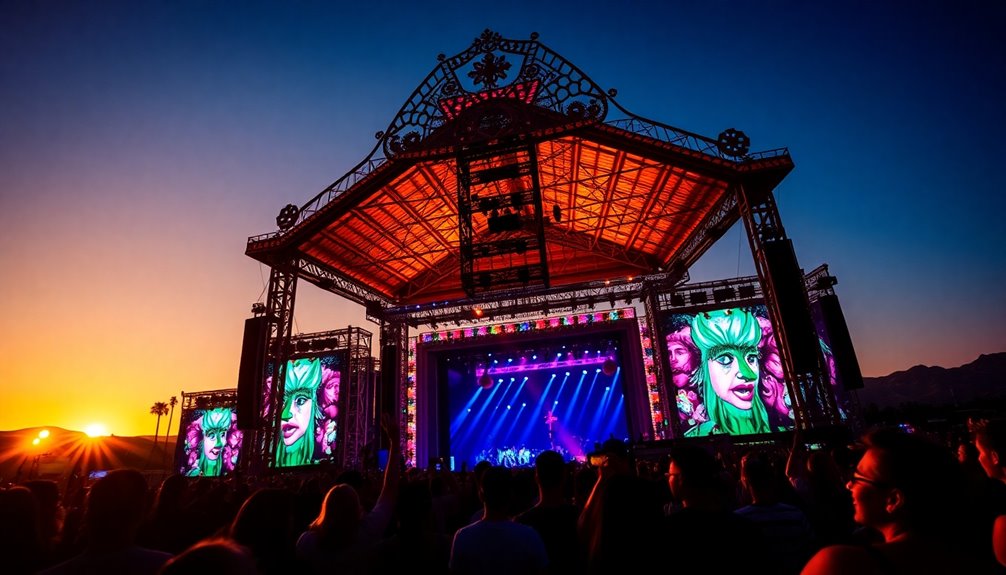
Coachella has become a cultural touchstone, thanks in large part to the iconic performances that have defined its history.
You can’t forget Daft Punk’s 2006 pyramid stage, which revolutionized electronic music. Rage Against the Machine’s energetic 1999 headlining act set the tone for future festivals, while Beyoncé’s historic 2018 performance showcased Black excellence and earned the nickname “Beychella.” Often referred to as America’s greatest music festival, Coachella attracts a diverse crowd and generates significant media attention. Prince’s stunning eight-minute cover of “Creep” in 2008 highlighted his versatility. Then there’s the unforgettable Tupac hologram in 2012, pushing live performance boundaries.
Each of these moments not only captivated audiences but also shaped the festival’s legacy, making Coachella a must-attend event for music lovers worldwide.
The Art Installations Transforming the Festival

Music isn’t the only element that makes Coachella unforgettable; the festival’s art installations play a pivotal role in shaping the experience. Towering up to 85 feet, these massive creations engage you culturally, often mirroring Southeast Asian temple idols and emphasizing diversity. The concept of cultural significance is evident as these artworks reflect the rich narratives of various communities.
Crafted from durable materials like wood and steel, they require months of collaboration. As you wander through the desert, the installations transform the landscape into an open gallery, merging art with nature. The annual Coachella Valley Music and Arts Festival showcases a variety of art exhibitions, creating an immersive and grandiose visual spectacle.
From day to night, dynamic displays with light and projections captivate your senses. Many pieces encourage interaction, enhancing the festival’s atmosphere and fostering connections among attendees. Ultimately, these installations not only enrich your experience but also contribute to the cultural identity of the festival.
Coachella’s Cultural Impact and Legacy
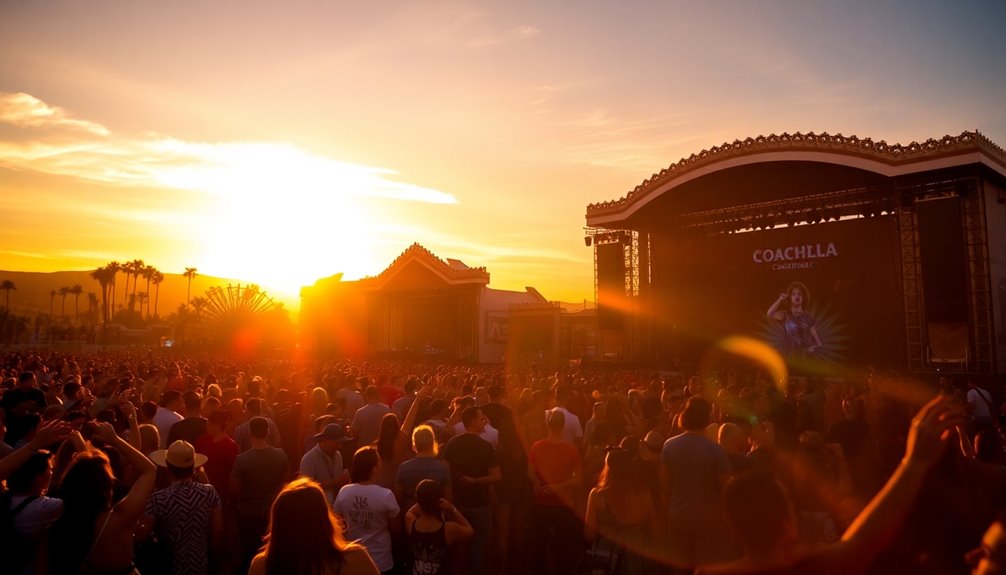
Cultural vibrancy defines Coachella’s impact, as the festival transcends mere music to shape trends in art, fashion, and social interaction. It’s a global phenomenon, influencing styles and sounds worldwide. You see its economic boost in the Coachella Valley, where local businesses thrive, with the festival generating hundreds of millions in economic activity annually. Social media amplifies this reach, making Coachella a cultural touchstone. The diverse lineup reflects a commitment to representation, showcasing emerging talents alongside established stars. Fashion-forward attendees use the festival to express their unique styles, setting trends that extend beyond the event. As attendance has skyrocketed, so has Coachella’s legacy as a platform for change, sustainability, and cultural dialogue, ensuring its place in the hearts of festival-goers everywhere.
Frequently Asked Questions
What Are the Dimensions of Each Coachella Stage?
You’re curious about the dimensions of each Coachella stage.
The Coachella Stage is the largest, typically around 100 feet wide, designed to host headliners.
The Sahara Tent, known for EDM, measures approximately 150 feet by 300 feet.
The Outdoor Theatre offers an intimate setting, roughly 100 feet wide, while both the Mojave and Gobi Tents are mid-size, each around 100 feet by 200 feet, accommodating a variety of acts.
How Are Artists Selected to Perform on Each Stage?
Artists are selected for each Coachella stage based on their performance style, genre alignment, and audience engagement.
You’ll find high-energy acts on the Sahara Tent, while more intimate performances happen at the Outdoor Theatre.
The selection process involves a curatorial team reviewing submissions, analyzing current music trends, and considering technical requirements.
Past performances and industry recommendations also play a role, ensuring a diverse lineup that resonates with festival-goers.
What Safety Measures Are Implemented at the Festival Stages?
At festival stages, you’ll notice several critical safety measures in place.
Stages are built to ensure structural integrity and undergo rigorous load testing. You’ll find multiple emergency exits and well-positioned lighting and sound systems.
Crowd management includes barriers and trained security personnel to monitor behavior. On-site medical teams, hydration stations, and first aid facilities offer immediate assistance.
Additionally, security checkpoints and surveillance systems help maintain a safe environment for everyone.
Are There Backstage Tours Available During Coachella?
You won’t find any backstage tours available during Coachella for general attendees. The festival keeps backstage access restricted, ensuring artists and crew can work without interruptions.
If you’re looking for a more exclusive experience, consider investing in VIP passes. While these won’t grant you a tour, they do offer special areas and amenities that enhance your overall festival experience.
Enjoy the music and art from your vantage point, soaking in the vibrant atmosphere!
What Types of Equipment Are Used for Stage Productions?
For stage productions, you’ll find a variety of equipment that enhances the visual and auditory experience.
Lighting fixtures like Elation and Vari-Lite create stunning effects, while video walls made of ROE Carbon CB8 tiles deliver vibrant visuals.
Trusses and structures support the setup, ensuring stability.
Control systems, like MA Lighting consoles, manage everything seamlessly.
Together, these elements create a captivating performance environment that keeps the audience engaged and immersed in the show.
Conclusion
As you reflect on Coachella’s iconic stages, you realize that each space tells a unique story. From the grandeur of the main stage to the intimate vibes of the Mojave Tent, every performance leaves its mark. The art installations add a vibrant layer, transforming the festival into a cultural masterpiece. Coachella isn’t just about music; it’s a living testament to creativity and connection. You can’t help but feel inspired by its lasting impact on the music scene.








